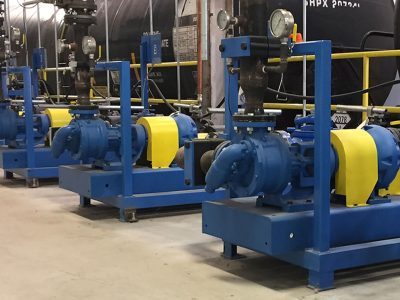
Understandably so, in the pump industry our focus is primarily on the power delivered BY the pump. How much flow is required and at what pressure? Here at Viking Pump and at our channel partners we have hundreds of experts on this topic. Once we’ve solved for this, we then need to shift our focus to providing power TO the pump. Unfortunately, there seems to be some confusion on the topics of torque and horsepower and their relationship.
Loosely speaking, torque is a measure of the turning force on an object. For example, pushing or pulling the handle of a wrench connected to a nut or bolt produces a torque (turning force) that loosens or tightens the nut or bolt. Torque applied to a pump shaft starts its rotation and is required to continue turning the pump. Centrifugal pumps (and other machines like fans) are variable torque machines and will not be covered here. Viking positive displacement pumps are constant torque machines; regardless of speed, the torque should be more or less constant.
Variable Frequency AC drives (VFD) are also constant torque machines. This means that a variable speed motor can be directly coupled to a Viking pump to vary the speed and capacity of the pump.
So if torque is a force applied to the pump shaft, isn’t horsepower the same thing? Not exactly. Horsepower is work done over time. So torque and horsepower are related, but they are not interchangeable. Each can be calculated using the equations below. When using units of HP for power and ft-lbs for torque, the constant is 5252.
HORSEPOWER = (Torque x Speed)/Constant
TORQUE = (Horsepower x Constant)/Speed
So when running a VFD at reduced speed, torque remains constant, but horsepower is reduced.
Occasionally, a customer mistakes constant torque for constant horsepower. This can lead them to supplying motors that are undersized when designed to run with a VFD below their rated synchronous speed. Since the horsepower decreases proportionally with the speed, the motors are only rated to a fraction of their rated horsepower when run at lower speeds. Selecting a motor that will be used with a VFD can be done, but you have to account for the decrease in horsepower as the speed decreases. If the motor is running at only 50% of its speed, it must be rated to twice the power required by the pump (i.e. if the pump required 5 HP from the curve, a 10HP motor running at 50% speed could be used).
There are devices which can deliver constant horsepower by converting the high speed/low torque of the motor into low speed/high torque for the pump shaft; you know them as gear reducers. Since the power into the reducer is the same as the power out, no oversizing of the motor would be necessary for the application. This is why when pumps are significantly reduced in speed a reducer is recommended.
Cooling of the motor becomes a concern when running at slower speeds, which is why motors are limited in the amount of turndown they can do. When selecting a motor that will be used with a VFD, the constant torque turndown rating for the motor must be adequate for the speed reduction required for the application.
A guest post from Viking Pump


